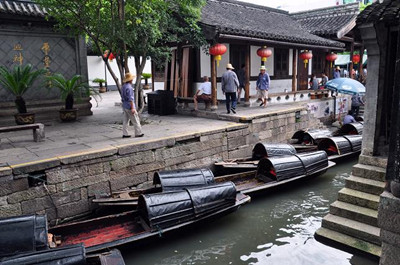Shaoxing lies in northern Zhejiang Province on the southern shore of the Hangzhou Bay. A famous ancient city south of the Yangtze River and the hometown of Lu Xun (1881-1936), China's great twentieth century writer, it was the capital of the State of Yue of the Spring and Autumn Period some two thousand years ago. Shaoxing is a town of rivers and canals, arch bridges and boats. Tourists will find a number of interesting places to visit in the city and its vicinity.
King Yu Temple and Tomb
This site is located four kilometers southeast of Shaoxing. King Yu or the great Yu was believed to be the King of Xia, the legendary first Chinese dynasty of the twenty-second to sixteenth century B.C. He was remembered for his extraordinary efforts in flood control. The temple which was first built in the sixth century and has since been rebuilt on many occasions is composed of Meridian Gate (Wumen), Memorial Hall, and the Main Hall, all built on the same axis. Da Yu's statue stands inside the magnificent twenty-four-meter-high Main Hall, which is double-eaved with painted ridge poles and engraved beams. The Goulou Pavilion in front of meridian Gate houses a monument, also named Goulou, which is said to have been erected by King yu when he was taming the flood. In the Burial Stone Pavilion (Bianshiting) east of the temple is a two-meter-high cone-shaped stone believed to have been used at King Yu's funeral. King Yu's tomb sits to the left of the temple.
Lanting Pavilion
Located at the foot of Lanzhou Hill fourteen kilometers southwest of Shaoxing, this pavilion is where the master calligrapher Wang Xizhi of the Eastern Jin Dynasty (317-420) wrote a famous essay about his meeting with some friends here in 353. While in high spirits, Wang Xizhi wrote an article called "Prologue to the Lanting Pavilion Collection". Eminent and praiseworthy in both calligraphy and literary talent, this article became a masterpiece in these two fields. Wang Xizhi was crowned as the "sage of calligraphers" from then on and this pavilion came to prominence from this event. Now, Orchid Pavilion has been regarded as the Mecca for calligraphers. The existing garden and buildings were rebuilt in 1548. A small stream, called Curved Stream (Qushui), runs through the secluded garden, with Liushang Pavilion on its bank. Nearby, at Goose Pond (Echi), there is another pavilion which houses a stone tablet engraved with two Chinese characters: "E, Chi," said to be in Wang Xizhi's brush writing.
Lu Xun's Former Residence
The residence, a two-storied wooden structure in traditional style, is found at 208 Lu Xun Road in Shaoxing. Lu Xun lived here until he went to study abroad. He received revolutionary soldiers and young students here from 1910 to 1912 when he returned home to teach in a local school, and it was here that he wrote his first novel. To the east of the residence is the Three Flavor Study (Sanweishuyu), a private school that Lu Xun attended during his childhood.

East Lake
East Lake is located in the east suburbs of Shaoxing city, three kilometers from the city center. Featuring an elegant landscape of lakes and mountains and fantastic stones, it, together with the West Lake in Hangzhou and Nanhu Lake in Jiaxing, are known as the Three Famous Lakes in Zhejiang Province.
East Lake used to be a huge rocky hill. During the Han Dynasty, stoneman always went there to quarry stone. During the Sui, in order to build the great Wall, more stone were quarried from the mountain. After thousands of years of excavation, some parts of the mountain were hollowed, forming a unique scene.
The scenic area consists of Taogong Cave, Xiantao Cave, Tingqiu Pavilion and other spots. "Taogong Dong" is located at the food of the hill with cliffs rising 50-60 meters on each side. Riding on the lake in a boat, visitors can fully enjoy the wonderful scene. There are nine bridges on the lake and many pavilions dotted the banks. Visitors are sure to enjoy the beautiful scenery.











